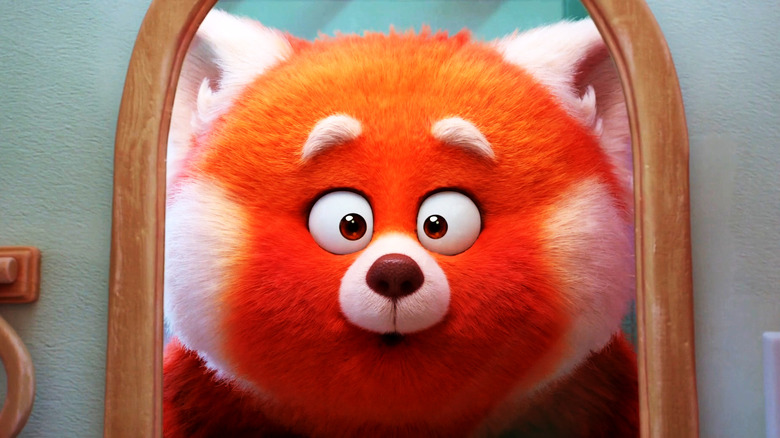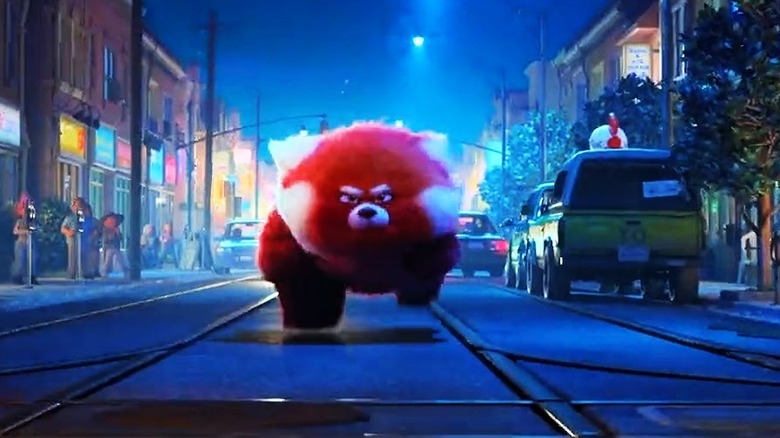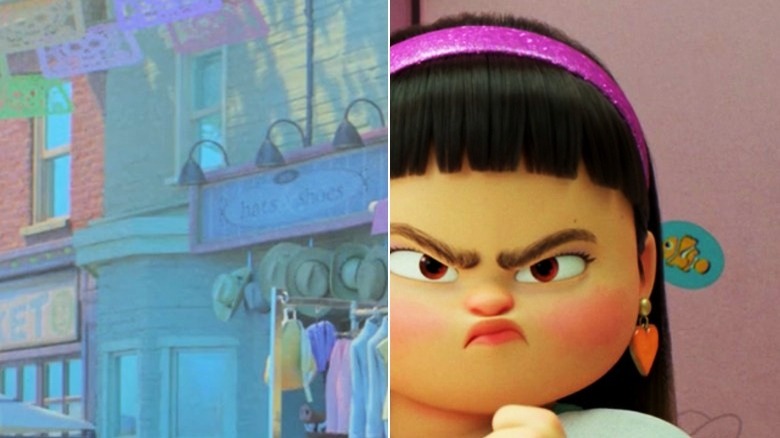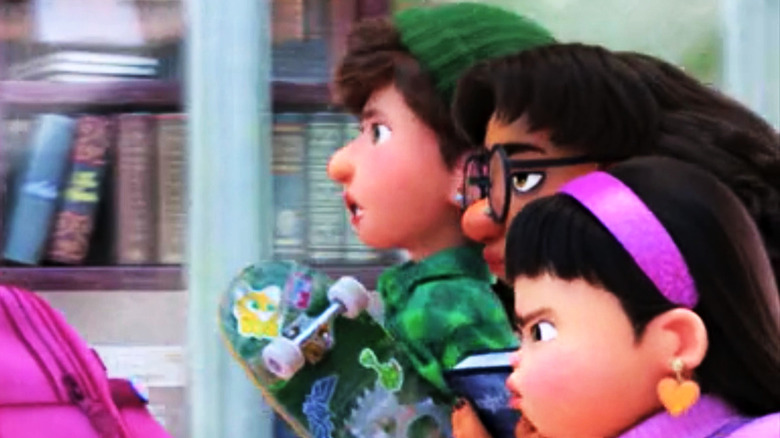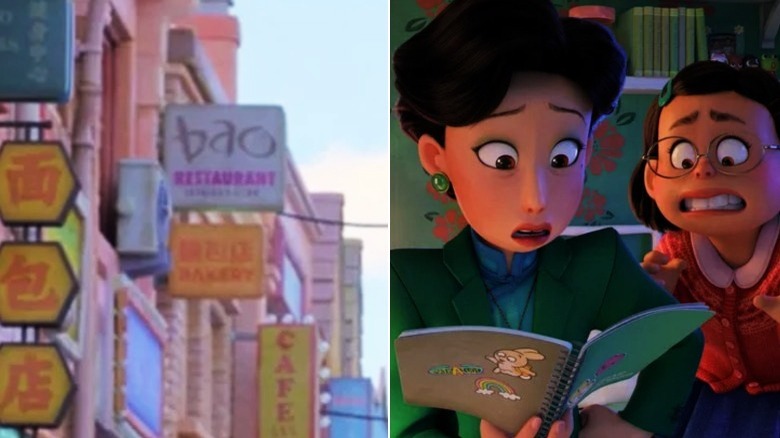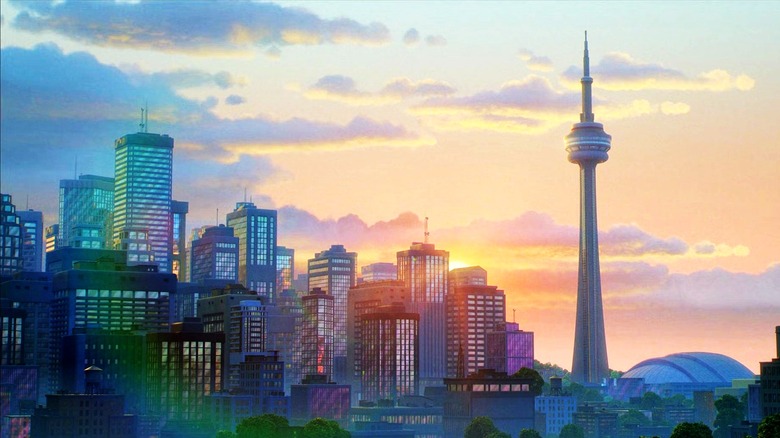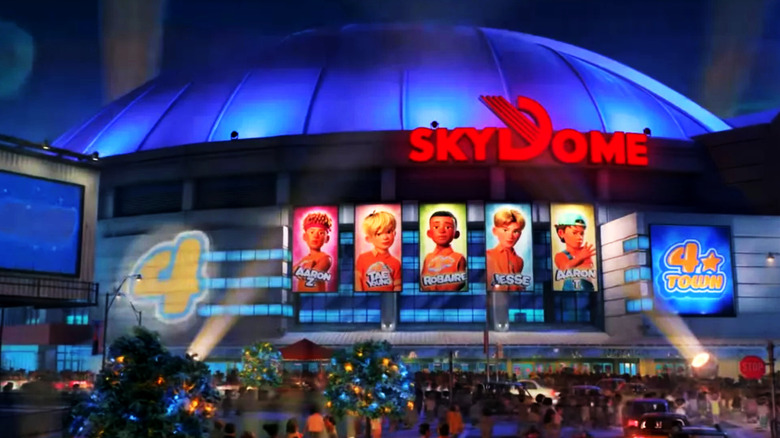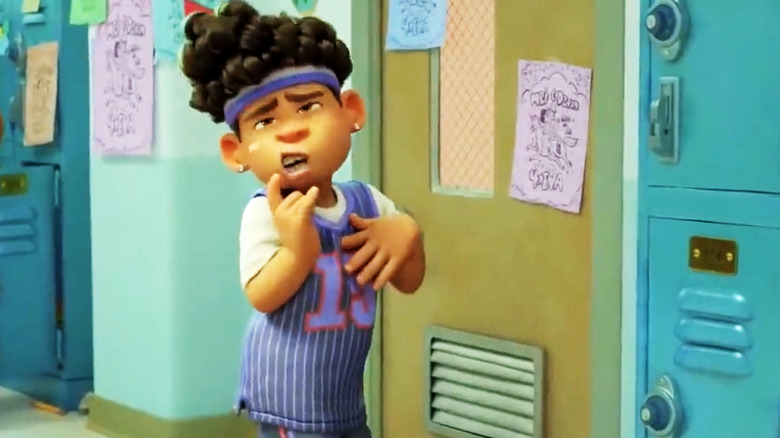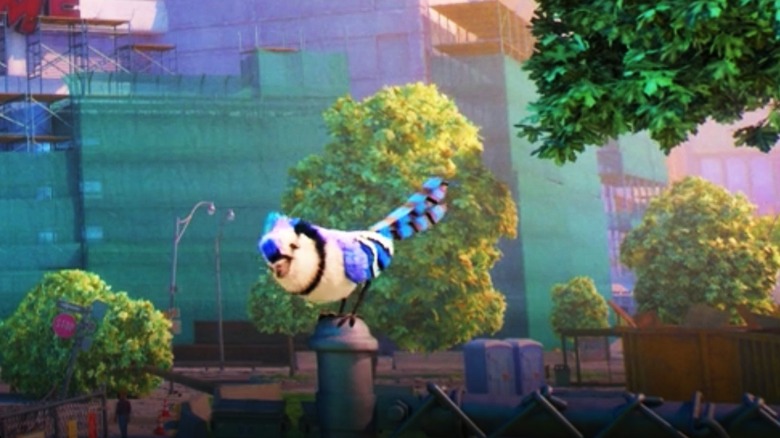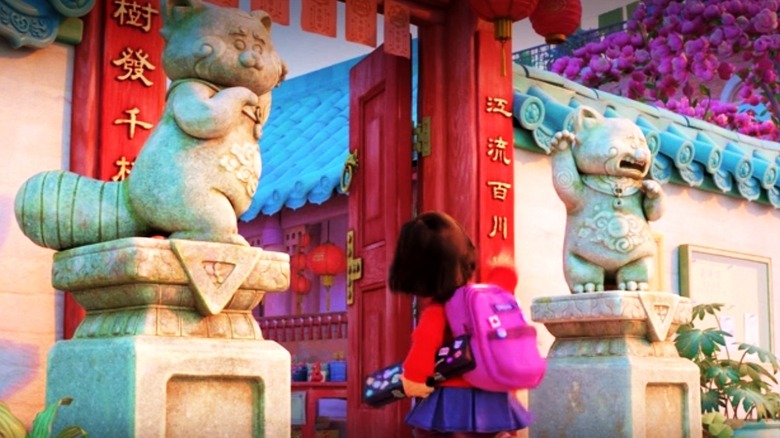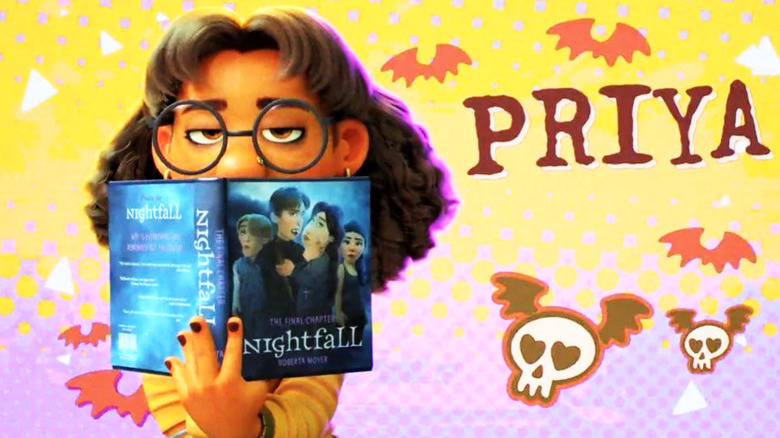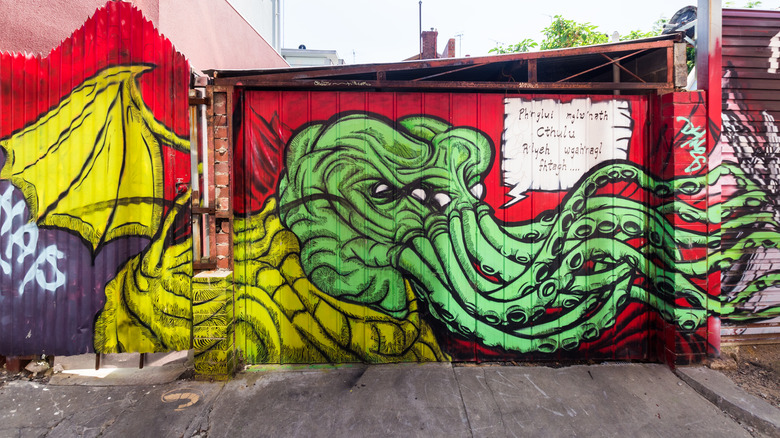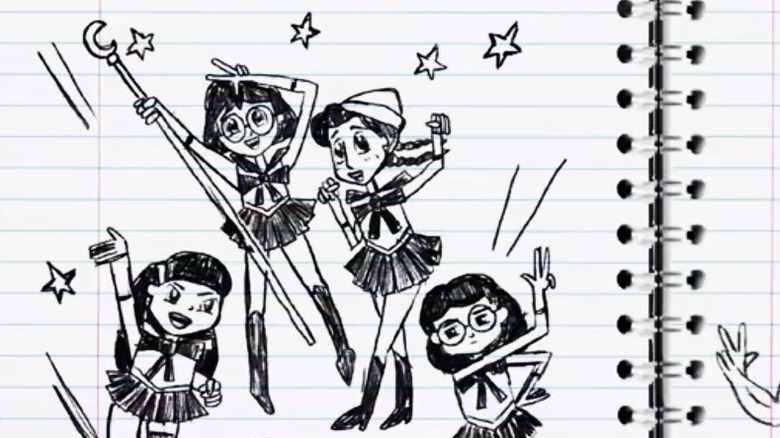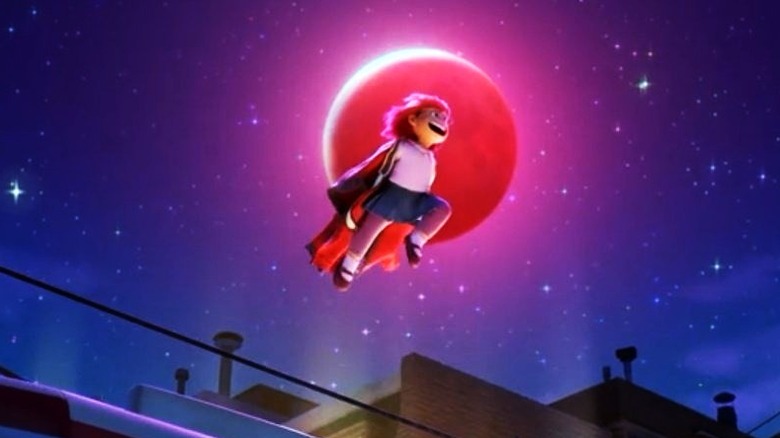Easter Eggs You Missed In Pixar's Turning Red
Like the all the best Pixar films, "Turning Red" is a movie that demands to be watched multiple times. This is both because it's really that good and because it's packed with details viewers might not notice the first time around. With "Turning Red" now streaming on Disney+, kids who love the movie can and will rewatch it as many times as they want, and the Pixar artists' attention to detail provides plenty for adults to get wrapped up in on repeat viewings.
Hardcore Pixar fans will be aware of certain Easter eggs to look out for in "Turning Red," as the studio regularly repeats various background gags and inside jokes between movies, but you might want some help locating them. Other Easter eggs in "Turning Red" are specific to the story's Toronto setting, to teen culture in the early 2000s, or to director Domee Shi's multiple anime influences. If you missed them the first time around, here's what to look out for when rewatching "Turning Red."
The following contains spoilers.
Three regular Pixar presences
The Pizza Planet truck from the "Toy Story" movies has appeared in every Pixar feature film except "The Incredibles" (though it did make the video game adaptation). In "Turning Red," the vehicle is visible on the street when Mei is charging towards the SkyDome at the film's climax. While fans have used the Pizza Planet truck and other Easter eggs to craft elaborate shared universe fan-theories, Domee Shi directly declared in an interview with LightsCameraJackson that "Turning Red" takes place in the same universe as the "Toy Story" films.
One Pixar Easter egg that shows up less regularly (but still fairly often) in the studio's filmography is the ball from "Luxo Jr," Pixar's first short film, which was made after the company split off from Industrial Light and Magic in 1996 and introduced the lamp character used in Pixar's logo. The yellow-and-blue ball with a red star, which Luxo Jr. squished in the short, shows up in "Turning Red" floating in the pool during Tyler's birthday party.
"Turning Red" also has two usages of Pixar's most insider running gag: A113, the name of the character animation classroom at CalArts. Many of Pixar's directors attended the famous art school, though Shi went to Sheridan instead. Nonetheless, this CalArts reference appears twice in "Turning Red" — first on a ticket to the 4*Town concert and again on the side of the chalk wheelbarrow used to draw the banishing circle.
References to past Pixar hits...
Beyond the big recurring Easter eggs, Pixar movies have always included background references to the studio's past hits, and "Turning Red" is no exception. "Coco," for example, is referenced at least twice: The film's papel picado (tissue paper art) skull design hangs from one of the buildings Mei passes when she runs home from school panicking in her red panda form, and one of the boys she's attracted to wears a T-shirt bearing the name of the band "Escápula."
But it doesn't end with "Coco." A sticker of the clownfish title character from "Finding Nemo" is visible on a bathroom stall when Mei and her friends put together their big plan to get 4*Town concert tickets. One kid's flip-phone has a sticker of the unicorn character from "Inside Out." A bird skeleton in a classroom bears a resemblance to Kevin from "Up." Even the cloud formations in one scene reference Andy's wallpaper from the "Toy Story" movies.
...and future blockbusters
Pixar movies don't only reference past films, but future ones as well. "Turning Red" itself was teased in "Luca" via a "4*Villagi" album (Italian for "4*Town") in Alberto's room, and now it does the same favor for Pixar's next film, "Lightyear." The "Lightyear" Easter egg shows up early on in the movie, when Mei is walking down the street with her best friends Miriam, Priya, and Abby. Miriam is a skater, and among the various stickers on her skateboard are a variation on the Space Rangers logo and a picture of "Lightyear" character Sox.
Sox is a yellow robot cat who becomes Buzz Lightyear's "personal companion" in the "Toy Story" spinoff film. His scenes have already gotten the biggest laughs in the "Lightyear" trailer, and he promises to become yet another lovable Pixar favorite. "Lightyear" is supposedly the movie that inspired the Buzz Lightyear toys in the "Toy Story" universe — given that "Turning Red" takes place in the same universe, it's likely Miriam grew up loving the same film Andy did.
Pixar shorts references
Domee Shi won the best animated short subject Oscar for her 2018 short film "Bao," another story about Chinese-Canadian mothers learning to let go of their over-controlling parenting styles. In her first feature film, she calls back to the short that first got her noticed, and not only through similar themes. Among the various storefronts shown in Toronto's Chinatown in "Turning Red" is a sign for "Bao Restaurant," with the word "Bao" written in the same font as the title of Shi's directorial debut.
In addition to the "Bao" and "Luxo Jr." references, "Turning Red" features several references to films from Pixar's SparkShorts program, which has worked to give diverse talent within the studio more opportunities as directors. The bunny protagonist of Madeline Sharafian's hand-drawn 2020 short "Burrow" appears as a sticker on Mei's notebook (this same sticker is also prominent in the upper left of the film's poster). On Mei's desk, you can also see a pink yarn toy referencing "Purl," the 2018 SparkShort directed by Kristen Lester.
The film has many Toronto-specific details...
"Turning Red" is, among many other things, a love letter to Toronto, and those who've lived in or visited the capital of Ontario, Canada, will notice many details otherwise unremarked upon by everyone else. According to local Toronto news site blogTO, these Easter eggs have been a source of excitement for viewers in the city.
Some of the most notable Toronto-specific details in "Turning Red" include the omnipresence of the CN Tower, the fact that Mei's older crush, Devon, works in a Daisy Mart, and direct references to the Toronto Transit Commission (even though the film doesn't use the official logo on Mei's TTC card). Mei's school, Lester B. Pearson Middle School, is named for Canada's 14th prime minister and shares a name with many real Canadian schools, even if there isn't one directly near Chinatown in real life. Other, smaller Toronto-relevant references include the city's unique three-opening garbage cans and various architectural details.
...including some specific to 2002
If you've only been to Toronto recently, you might not immediately recognize all the local Easter eggs, since "Turning Red" is set in 2002. One major detail which brings back nostalgia for Toronto residents back in the '90s and early '00s is the usage of the SkyDome for the film's climactic concert. The stadium still exists, but since 2005, it's gone by a different name: the Rogers Centre. Most of the kids and teenagers who make up the primary target audience of "Turning Red" weren't even alive when the place was called the SkyDome.
This isn't the only thing that's changed between the Toronto of 2002 and the Toronto of 2022, and "Turning Red" generally stays true to the details of its time period. Some of the Toronto Transit Commission streetcars seen in the movie have been retired in real life, and the Tim Hortons Timbits box shown at the Lee family breakfast table reflects an older style of packaging which can no longer be found.
Tyler's hero worship
Tyler tries to keep his love for 4*Town (specifically Aaron Z.) a secret, but looking back at the film, it appears as if the school bully secretly tries to style himself after Aaron Z — he wears a similar hairband and both characters have the same earrings. If Tyler's fashion choices are clues to his fandoms, it's clear that in addition to the 4*Towner, he's a fan of basketball player Vince Carter.
Carter played for the Toronto Raptors basketball team from 1998 to 2004, so he would have been around at the time "Turning Red" takes place. The Raptors' jerseys were purple at the time, and Carter wore number 15; the jersey Tyler is always wearing is also purple with the number 15. This isn't the first time Domee Shi and Pixar have snuck a Vince Carter reference into an animated film, either — a boy in "Bao" is seen wearing the same jersey.
A dual Pixar-Toronto reference
"Turning Red" is packed with both Pixar-based Easter eggs and Toronto-based Easter eggs, so it's not completely surprising that the people making the movie figured out a way to fit in an Easter egg that's simultaneously a reference to both Pixar and Toronto. The dual reference comes at the end of the film, when the SkyDome is undergoing repairs following "Pandapocalypse 2002" and a blue jay perches on a fence outside the construction site.
The Toronto connection is that the Toronto Blue Jays are the Major League Baseball team that calls the Rogers Centre (formerly the SkyDome) its home. The Pixar connection is that this particular blue jay model is the exact same one that was used in the Disney+ "Up" spin-off show "Dug Days." The show's fifth episode, "Science," involves a squirrel and a blue jay getting translator devices that allow them to speak with Dug.
Mei is a Simpsons fan
The opening scenes of "Turning Red," in which Mei breaks the fourth wall to introduce the audience to her life, move at such a fast pace that it's easy to miss some clever touches in the dialogue. One of these touches is that, when Mei first arrives at her family's temple, she greets the two red panda statues at the entrance by saying, "Hi, Bart. Hi, Lisa." The clear implication is that she named the statues after the brother and sister duo from "The Simpsons."
"The Simpsons" has been on TV since 1989, so this reference is as at home in the 2002 setting of "Turning Red" as it would be in a movie set a decade earlier or a decade later. With Disney fully acquiring the 20th Century Fox film and TV library, including "The Simpsons," in 2019, this reference now serves not only as pop culture context but as company synergy. A "Simpsons" short film titled "Playdate with Destiny" previously played in front of Pixar's "Onward" during its brief 2020 theatrical run.
Priya's vampire obsession
It's hard to miss the fact that the book Priya is reading when she's first introduced — "Nightfall: The Final Chapter" by Roberta Moyer — is a thinly-veiled parody of the "Twilight" series by Stephenie Meyer. Unlike other Easter eggs, this parody is something of an anachronism (the first "Twilight" book was published in 2005, years after when "Turning Red" is supposed to take place), but it serves to introduce a character trait that's otherwise presented much more subtly: Priya really wants to be a vampire.
Pay close attention to Priya's movements and poses in various group scenes and you'll likely see her engaging in vampire-inspired behavior, whether it's lying down with her arms crossed over her chest or pretending to curse or hypnotize those who cross her. Given her parents are so restrictive they won't let her attend the 4*Town concert with her friends, it's likely she's not allowed to go full goth, but she shows attraction to one of the goth girls at Tyler's birthday party. "Turning Red" might be Mei's story, but it provides enough details that attentive viewers can work out other characters' personal stories, as well.
'Thank Cthulhu'
When Mei finally shows up at Tyler's birthday party, Priya exclaims, "Thank Cthulhu!" As fans of horror literature know, Cthulhu is the High Priest of the Great Old Ones in the writings of early 20th-century author H.P. Lovecraft — in Lovecraft's mythos, the winged, tentacle-faced Cthulhu once ruled the Earth as a god and is still worshipped by cultists while hibernating in the underwater city of R'lyeh.
Though the character's creation dates back to a 1928 short story and references to him have been included in books and games by various authors over the ensuing decades, Cthulhu truly gained prominence in the broader cultural consciousness via memes and parodies throughout the 2000s and 2010s. The rise of Cthulhu's memetic popularity has led to a rise in deconstructions of H.P. Lovecraft's work, with books and TV shows such as "Lovecraft Country" taking aim at the racism and xenophobia that fueled the author's mythology while appropriating his horror imagery in new and compelling ways. Priya's mock-worship of the Great Dreamer and Sleeper of R'lyeh fits with her characterization as a dark, edgy, bookish kid growing up in the 2000s.
Multiple Sailor Moon references
"Turning Red" and its animal-transformation-based premise draws heavy inspiration from anime like "Fruits Basket" and "Ranma 1/2," with "Ranma" and "InuYasha" creator Rumiko Takahashi being a major influence on the movie's art style. The anime which receives the most direct homages in "Turning Red," however, is the classic magical girl series "Sailor Moon," which makes sense as the type of show a group of 13-year-old girls would be obsessed with in 2002.
Alongside quadratic formulas and various sexy centaurs and mermaids, Mei's notebook also includes drawings of her and her friends as the Sailor Scouts, and the aunties' transformation sequence pays clear homage to similar transformation sequences from "Sailor Moon" and other magical girl anime. Arguably the "Sailor Moon" reference viewers are most likely to miss comes in how the film illustrates the Toronto skyline at night in the exact same style as "Sailor Moon" presented the night skyline of Tokyo.
Mei leaps through time
This is an Easter egg that should be easily noticeable to those who've seen Mamoru Hosoda's 2006 anime film "The Girl Who Leapt Through Time," but given millions more people are likely to watch "Turning Red" than have ever seen "The Girl Who Leapt Through Time," this reference will almost certainly be missed by many. It occurs during Mei's "superhero" moment, when she realizes she can use her red panda transformation abilities to leap over buildings. The pose she makes while leaping in human form is identical to the pose Makoto Konno makes when leaping through time in Hosoda's film.
Shi acknowledged this shot was a direct homage to "The Girl Who Leapt Through Time" in an interview with Hosoda himself posted on the Japanese Disney+ YouTube channel. Hosoda, for his part, was impressed with the animation and storytelling quality of "Turning Red" and drew fan art of Mei together with the protagonist of his 2020 anime film "Belle."
